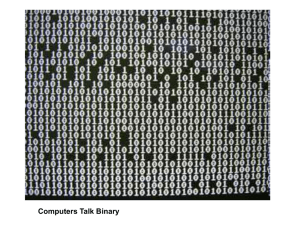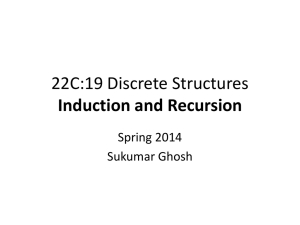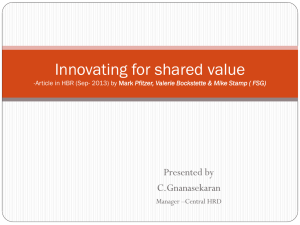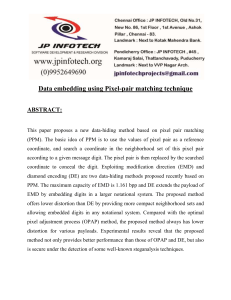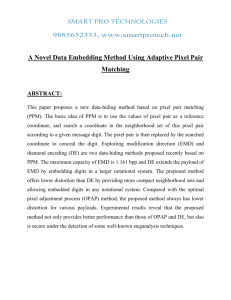Improving Various Reversible Data Hiding
advertisement
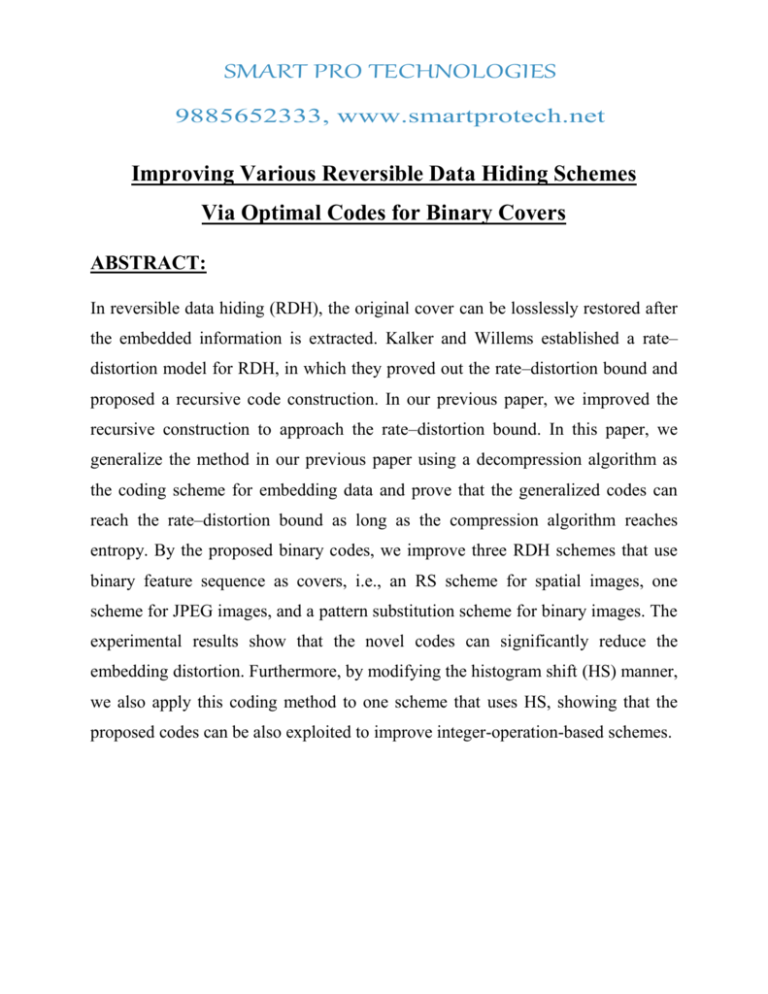
SMART PRO TECHNOLOGIES 9885652333, www.smartprotech.net Improving Various Reversible Data Hiding Schemes Via Optimal Codes for Binary Covers ABSTRACT: In reversible data hiding (RDH), the original cover can be losslessly restored after the embedded information is extracted. Kalker and Willems established a rate– distortion model for RDH, in which they proved out the rate–distortion bound and proposed a recursive code construction. In our previous paper, we improved the recursive construction to approach the rate–distortion bound. In this paper, we generalize the method in our previous paper using a decompression algorithm as the coding scheme for embedding data and prove that the generalized codes can reach the rate–distortion bound as long as the compression algorithm reaches entropy. By the proposed binary codes, we improve three RDH schemes that use binary feature sequence as covers, i.e., an RS scheme for spatial images, one scheme for JPEG images, and a pattern substitution scheme for binary images. The experimental results show that the novel codes can significantly reduce the embedding distortion. Furthermore, by modifying the histogram shift (HS) manner, we also apply this coding method to one scheme that uses HS, showing that the proposed codes can be also exploited to improve integer-operation-based schemes. SMART PRO TECHNOLOGIES 9885652333, www.smartprotech.net ARCHITECTURE: EXISTING SYSTEM: Most data hiding methods embed messages into the cover media to generate the marked media by only modifying the least significant part of the cover and, thus, ensure perceptual transparency. The embedding process will usually introduce permanent distortion to the cover, that is, the original cover can never be reconstructed from the marked cover. However, in some applications, such as medical imagery, military imagery, and law forensics, no degradation of the original cover is allowed. SMART PRO TECHNOLOGIES 9885652333, www.smartprotech.net DISADVANTAGES OF EXISTING SYSTEM: In existing systems, there are still limitations in three aspects. First, the recursive code construction is close to but cannot reach the rate– distortion bound. Second, the codes in existing systems are restricted to some discrete embedding rates and cannot approach the maximum embedding rate at the least admissible distortion. Third, the codes are restricted to improve Type-I RDH for spatial images, and how to improve Type-II RDH by binary codes is still a problem PROPOSED SYSTEM: We prove that the recursive code construction can reach the rate–distortion bound when the decompression/compression algorithms used in the code are SMART PRO TECHNOLOGIES 9885652333, www.smartprotech.net optimal, which establishes equivalence between source coding and RDH for binary covers. With the decompression of the adaptive arithmetic coder (AAC) as the embedding code, the proposed codes realize continuous embedding rates and reach the maximum embedding rate at the least admissible distortion. A method is presented to improve integer-operation-based RDH (Type II) by the proposed binary codes, which are also applied to Type-I RDH for JPEG and binary images. ADVANTAGESF OF PROPOSED SYSTEM: Higher embedding rate. Improve the recursive construction by using not only the joint encoding above but also a joint decoding of feature decompression and message extraction. The proposed code construction significantly outperforms previous codes and is proved to be optimal when the compression algorithm reaches entropy. MODULES: SMART PRO TECHNOLOGIES 9885652333, www.smartprotech.net Coding Model Recursive Construction Optimality Improving the Scheme for JPEG Images MODULES DESCRIPTION: Coding Model Throughout this paper, we denote matrices and vectors by boldface fonts and use the same notation for the random variable and its realization, for simplicity. To do RDH, a compressible feature sequence should be first extracted from the original cover. For Type-I schemes, the features can be usually represented by a binary sequence. Therefore, we directly take the binary feature sequence as the cover to discuss the coding method and follow the notation established. Recursive Construction This recursive construction performs better than the simple method because of two key points: 1) The data is embedded by an efficient nonreversible embedding code, SMART PRO TECHNOLOGIES 9885652333, www.smartprotech.net and 2) the cover block is compressed under the condition of the marked block. However, the above recursive construction cannot approach the upper bound (2) Optimality The next theorem shows that the proposed code construction is optimal as long as the compression algorithm is optimal. Improving the Scheme for JPEG Images In this subsection, we apply the codes to the reversible embedding scheme for JPEG images proposed by Firdrich and Goljan. In themethod in, quantized DCT coefficients that are equal to 0 and 1 at middle or high frequency are selected to form a compressible binary sequence. In our experiments, the test images are generated by compressing test images in Fig. 7 into a JPEG format with quality factor 80. We construct the binary cover by extract 0–1 coefficients from 11 positions, such as (3, 3), (2, 4), (4, 2), (1, 5), (5, 1), (3, 4), (4, 3), (2, 5), (5, 2), (1, 6), and (6, 1), from every 8 8 block of quantized DCT coefficients. Random messages are embedded into the binary cover by using Fridrich and Goljan’s method and the proposed codes with several kinds of embedding rates. HARDWARE REQUIREMENTS SYSTEM : Pentium IV 2.4 GHz SMART PRO TECHNOLOGIES 9885652333, www.smartprotech.net HARD DISK : 40 GB FLOPPY DRIVE : 1.44 MB MONITOR : 15 VGA colour MOUSE : Logitech. RAM : 256 MB KEYBOARD : 110 keys enhanced. SOFTWARE REQUIREMENTS Operating system :- Windows XP Professional Front End :JAVA, Swing(JFC) Tool :Eclipse 3.3 REFERENCE: Weiming Zhang, Biao Chen and Nenghai Yu, “Improving Various Reversible Data Hiding Schemes Via Optimal Codes for Binary Covers”, IEEE TRANSCATIONS ON IMAGE PROCESSING, VOL.21, NO.6, JUNE 2012.
